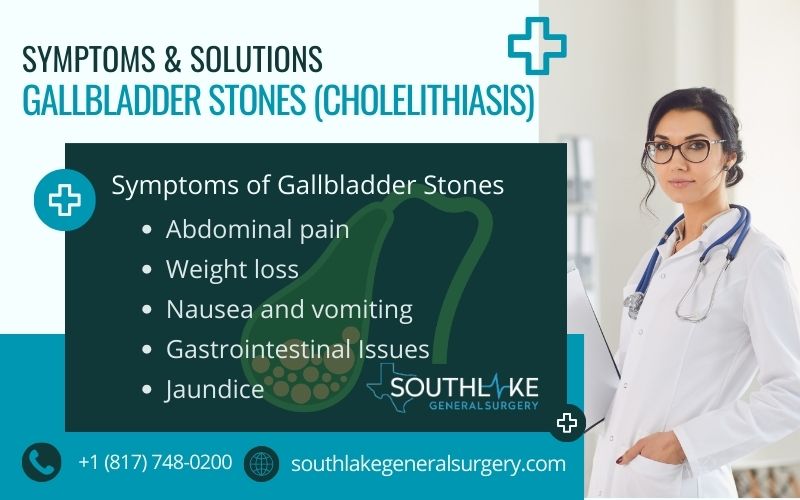Gallbladder stones or gallstones, also known as cholelithiasis, are hardened pieces of solid material that form in the gallbladder, a small organ located under the liver.
The gallbladder has a significant function in the digestive process as it stores and releases bile, a liquid created by the liver to aid in fat digestion. When the balance of cholesterol, bilirubin, and bile salts in the bile is disrupted, gallstones can form.
Gallstones can range in size from a grain of sand to a golf ball and can be composed of either cholesterol or pigment. Cholesterol stones are the predominant variety and typically exhibit a yellow-green color. They are made up of undissolved cholesterol and may also contain other substances such as bilirubin or bile salts. Pigment stones, on the other hand, are brown or black and are primarily made of bilirubin. People with liver disease or certain blood disorders are more likely to develop pigment stones.
Most gallstones do not cause any symptoms and are referred to as “silent gallstones.” They are typically discovered incidentally during imaging tests for other conditions. However, when a gallstone blocks a bile duct, it can cause severe pain and lead to complications. It is important to recognize the symptoms of gallstones and seek medical attention if they occur.
Key Highlights
- Gallstones are pieces of solid material that form in the gallbladder and can vary in size from a grain of sand to a golf ball.
- Most gallstones do not cause any symptoms and do not require treatment.
- Symptoms of gallstones typically occur when a stone blocks a bile duct, causing pain in the upper right abdomen, lower chest, or back.
- Cholesterol stones are the most common type of gallstones, followed by pigment stones.
- Risk factors for gallstones include obesity, high cholesterol levels, rapid weight loss, and a family history of gallstones.
- Treatment options for gallstones include surgical removal of the gallbladder or non-surgical treatments to dissolve or break up the stones.
Understanding Gallbladder Stones
Gallbladder stones, also known as cholelithiasis, are solid formations that occur in the gallbladder, a small organ located under the liver. The gallbladder stores and releases bile, a fluid produced by the liver that aids in digestion. Bile is transported from the liver to the gallbladder through the common bile duct.
Cholelithiasis, or gallbladder stones, can be classified into two main types: cholesterol stones and pigment stones. Cholesterol stones are the most common type and are formed when there is an imbalance of cholesterol in the bile. They are usually yellow-green. Pigment stones, on the other hand, are made up of bilirubin, a substance produced during the breakdown of red blood cells. These stones are usually brown or black.
Gallbladder stones can vary in size, ranging from a grain of sand to a golf ball. They can cause symptoms when they block the flow of bile, leading to pain and other complications. Understanding the different types of gallstones and their formation can help in recognizing the symptoms and seeking appropriate treatment.
The Basics of Gallbladder Function and Health
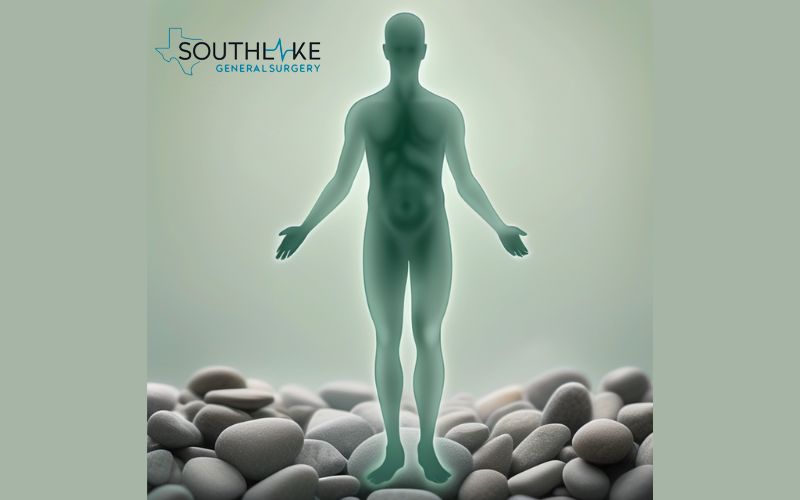
The gallbladder has a vital function in digestion. After food is digested in the stomach, it enters the small intestine, where bile is released from the gallbladder to aid in the breakdown and absorption of fats.
Bile is a fluid produced by the liver and stored in the gallbladder. It contains bile salts, cholesterol, bilirubin, and other substances necessary for digestion. When food enters the small intestine, the gallbladder contracts and releases bile into the common bile duct, which transports it to the small intestine.
In cases of liver disease or gallbladder inflammation, the flow of bile may be affected, leading to the formation of gallstones. Maintaining a healthy gallbladder is essential for proper digestion and overall health.
Different Types of Gallstones Explained
Gallstones can be classified into two main types: cholesterol gallstones and pigment stones.
- Cholesterol gallstones: About 80% of cases are attributed to these being the most prevalent type of gallstones. They are primarily composed of cholesterol that has not been dissolved in bile. Other substances, such as bilirubin or bile salts, may also be present in cholesterol gallstones.
- Pigment stones: Pigment stones are typically brown or black and are composed mainly of bilirubin. They are more commonly seen in individuals with liver disease or blood disorders that lead to excess bilirubin production. In some cases, gallstones may consist of a combination of cholesterol and pigment.
Both types of gallstones can vary in size, ranging from tiny grains of sand to larger golf ball-sized stones. The formation of gallstones occurs when there is an imbalance in the composition of bile, resulting in the deposition of substances that can solidify into stones.
Recognizing the Symptoms of Gallbladder Stones
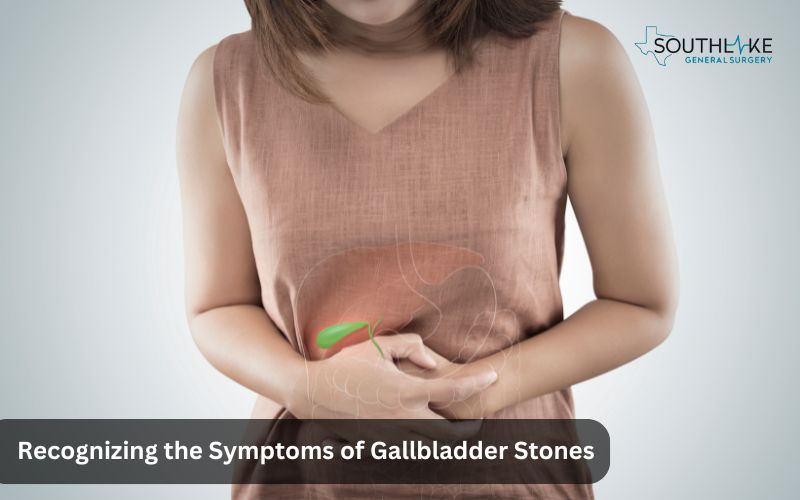
Symptoms of gallbladder stones may vary from person to person, and some individuals may not experience any symptoms at all. However, when gallstones cause a blockage in the bile duct or gallbladder, symptoms may occur. Common symptoms of gallbladder stones include:
- Discomfort experienced in the upper right abdomen, beneath the ribcage
- Pain in the lower chest, right shoulder, or back
- Upset stomach
- Nausea or vomiting
- Additional gastrointestinal issues like dyspepsia, acid reflux, and gas
These symptoms may arise during a gallbladder attack, also known as biliary colic, which occurs when a gallstone blocks the flow of bile. It is important to recognize these symptoms and seek medical attention for proper diagnosis and treatment.
Early Warning Signs and Symptoms of Gallstones
Gallstones can often go unnoticed until they cause a blockage or inflammation in the gallbladder or bile ducts. However, there are some early warning signs and symptoms that may indicate the presence of gallstones. These include:
- Abdominal pain: Gallstone pain often begins as a dull ache in the upper right abdomen and may radiate to the back or right shoulder. The pain can be intermittent or persistent and may worsen after eating fatty or greasy foods.
- Weight loss: Unexplained weight loss may occur due to the avoidance of certain foods that trigger gallstone symptoms or a decrease in appetite.
- Nausea and vomiting: Nausea and vomiting may occur as a result of the blockage or inflammation caused by gallstones.
If you experience any of these symptoms, it is important to consult with a healthcare professional who can perform diagnostic tests, such as an abdominal ultrasound, to confirm the presence of gallstones.
When to Seek Medical Attention for Gallstone Symptoms
While gallstone symptoms can vary in severity, there are certain situations in which it is important to seek immediate medical attention. These include:
- Severe pain: If you experience severe, persistent pain that lasts for several hours, it may indicate a serious complication such as a blocked bile duct or inflammation of the gallbladder.
- Inflammation of the gallbladder: Inflammation of the gallbladder, known as cholecystitis, can occur when a gallstone blocks the cystic duct. Symptoms consist of intense abdominal pain, fever, and sensitivity in the upper right abdomen.
- Jaundice: The presence of gallstones can lead to the blockage of the bile duct, causing a buildup of bilirubin in the bloodstream. This can result in jaundice and a yellowing of the skin and eyes.
- Pancreatitis: Gallstones may obstruct the pancreatic duct in certain situations, causing pancreas inflammation. This can cause severe abdominal pain, nausea, and fever.
If you experience any of these symptoms, it is important to seek immediate medical attention, as they may indicate a serious complication related to gallstones.
Causes and Risk Factors for Gallbladder Stones
Several factors can contribute to the development of gallbladder stones. Common causes and risk factors include:
- Obesity: The risk of developing gallstones is higher in individuals who are overweight or obese. Excess weight can lead to increased cholesterol levels in the bile, which can contribute to stone formation.
- High cholesterol levels: Too much cholesterol in the bile can lead to the formation of cholesterol gallstones.
- Excess bilirubin: Conditions that cause increased breakdown of red blood cells or impaired liver function can result in excess bilirubin in the bile, leading to the formation of pigment stones.
- Rapid weight loss: Losing a significant amount of weight in a short period of time, such as after weight loss surgery, can increase the risk of developing gallstones.
Other risk factors for gallbladder stones include a sedentary lifestyle, a high-fat diet, certain medical conditions such as diabetes, and a family history of gallstones. It is important to be aware of these risk factors and take steps to reduce the risk of developing gallbladder stones.
Lifestyle and Diet: Key Contributors to Gallbladder Issues
Lifestyle and diet play a significant role in the development of gallbladder issues, including the formation of gallstones. Certain dietary habits and lifestyle choices can contribute to an increased risk of developing gallbladder stones. Some key contributors include:
- Dietary fats: Consuming a diet high in saturated and trans fats can increase cholesterol levels in the bile, making it more likely for cholesterol gallstones to form. It is important to limit the intake of unhealthy fats and opt for healthier fats found in foods such as nuts, olive oil, and fish.
- Whole grains: Incorporating whole grains into your diet, such as whole wheat bread and brown rice, can help promote regular bowel movements and prevent the buildup of gallstones.
- Weight loss: Rapid weight loss or crash dieting can increase the risk of developing gallstones. It is important to approach weight loss in a gradual and sustainable manner to reduce the risk.
- Bile salts: Consuming a diet low in fiber and high in refined carbohydrates can interfere with proper bile salt metabolism, increasing the risk of gallstone formation. Including fiber-rich foods in your diet can help regulate bile salt levels.
By adopting a healthy lifestyle and making dietary choices that promote gallbladder health, you can reduce the risk of developing gallbladder issues, including gallstones.
Who is at Risk? Demographic and Genetic Factors
Certain demographic and genetic factors can increase the risk of developing gallbladder stones. These include:
- Gender and hormones: Women, especially those who have had multiple pregnancies or are on hormonal contraceptives, have a higher risk of developing gallstones. This is because estrogen increases cholesterol levels and slows down gallbladder emptying.
- Age: The risk of developing gallstones increases with age, particularly after the age of 40.
- Ethnicity: Certain ethnic groups, such as Native Americans and Mexican Americans, have a higher prevalence of gallstones.
- Genetic predisposition: A family history of gallstones can increase the likelihood of developing gallbladder stones.
- Gallbladder disease: Individuals who have a history of gallbladder disease, such as inflammation or infection, are at a higher risk of developing gallstones.
It is important for individuals who fall into these high-risk categories to be aware of the potential risks and take preventive measures to reduce the likelihood of gallstone formation.
Diagnosing Gallbladder Stones
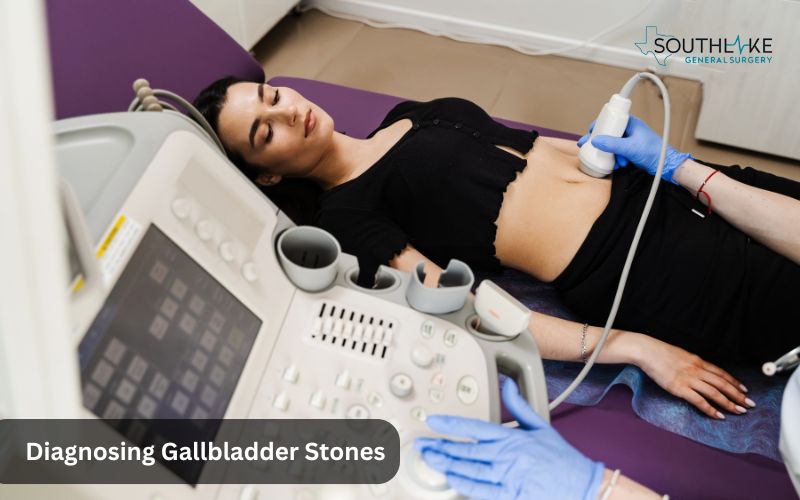
Diagnosing gallbladder stones typically involves a combination of medical history, physical examination, and diagnostic tests. Healthcare providers may use the following methods to diagnose gallbladder stones:
- Abdominal ultrasound: This non-invasive imaging test uses sound waves to create images of the abdomen and can show the presence of gallstones.
- HIDA scan: This nuclear medicine test involves injecting a radioactive substance into the bloodstream to evaluate the function of the gallbladder and detect blockages in the bile ducts.
- Endoscopic ultrasound: This procedure involves inserting a flexible tube with an ultrasound device into the digestive tract to obtain detailed images of the gallbladder and bile ducts.
- Blood tests: Blood tests can help identify signs of inflammation, infection, or liver dysfunction that may be associated with gallbladder stones.
A healthcare professional will review the results of these tests and make a professional diagnosis based on the findings. It is important to consult with a healthcare provider for an accurate diagnosis and appropriate management of gallbladder stones.
Professional Diagnosis: What to Expect During Your Visit
During a visit to a healthcare provider for the diagnosis of gallbladder stones, several steps may be involved. These include:
- Physical examination: The healthcare provider will perform a physical examination to assess any visible signs of gallbladder issues and evaluate the abdomen for tenderness or swelling.
- Medical history: The healthcare provider will review your medical history and ask questions about your symptoms, lifestyle, and any previous episodes of gallstone-related pain.
- Symptoms review: A detailed review of your symptoms will be conducted to understand the pattern, severity, and duration of pain or discomfort.
- Blood pressure and vital signs: Vital signs, including blood pressure and heart rate, may be checked to evaluate overall health.
- Liver function tests: Blood tests may be ordered to assess liver function and check for any abnormalities that may be associated with gallbladder stones.
These steps help healthcare providers gather important information to make a proper diagnosis and determine the appropriate course of treatment for gallbladder stones.
The Role of Imaging and Lab Tests in Gallbladder Stone Diagnosis
Diagnostic imaging and lab tests play a crucial role in the diagnosis of gallbladder stones. These tests provide valuable information about the presence and characteristics of gallstones. Some common tests used for diagnosis include:
- Abdominal ultrasound: This non-invasive imaging test uses sound waves to create images of the abdomen and can detect gallstones.
- HIDA scan: This nuclear medicine test involves injecting a radioactive substance into the bloodstream to evaluate the function of the gallbladder and detect blockages in the bile ducts.
- Blood tests: Blood tests can assess liver function, measure bilirubin levels, and check for signs of inflammation or infection associated with gallbladder stones. Liver enzyme levels may also be evaluated.
- ERCP, or endoscopic retrograde cholangiopancreatography: It is a diagnostic procedure used to identify and treat issues in the bile ducts and pancreas. This test can help differentiate between conditions like cholecystitis and gallstones.
The results of these tests, along with a thorough medical history and physical examination, help healthcare providers make an accurate diagnosis and determine the most appropriate treatment plan for individuals with gallbladder stones.
| Lab Test | Purpose |
| Abdominal ultrasound | Non-invasive imaging test to detect gallstones. |
| HIDA scan | Evaluates gallbladder function and detects blockages in the bile ducts. |
| Blood tests | Assess liver function and check for signs of inflammation, infection, or abnormal bilirubin levels. |
| ERCP | ERCP is a minimally invasive procedure used to examine the bile ducts and pancreas, diagnose issues like gallstones, and provide therapeutic relief for patients with gallbladder stones. |
Modern and Traditional Solutions for Gallbladder Stones
When it comes to treating gallbladder stones, there are a variety of options available. The most common approach is gallbladder removal surgery, which can be performed using laparoscopic or open techniques. Laparoscopic cholecystectomy entails creating minor incisions and utilizing specific instruments to extract the gallbladder. Open cholecystectomy is a more traditional approach that requires a larger incision.
In some cases, non-surgical treatments and home remedies may be recommended to dissolve gallstones or manage symptoms. These can include medications such as ursodeoxycholic acid, shock wave lithotripsy to break up stones, or dietary changes to prevent further stone formation.
The choice of treatment depends on several factors, including the size and number of gallstones, the severity of symptoms, and the individual’s overall health. Consulting with a healthcare provider is essential to determining the most appropriate treatment plan for gallbladder stones.
Surgical Approaches: From Open Surgery to Laparoscopic Surgery
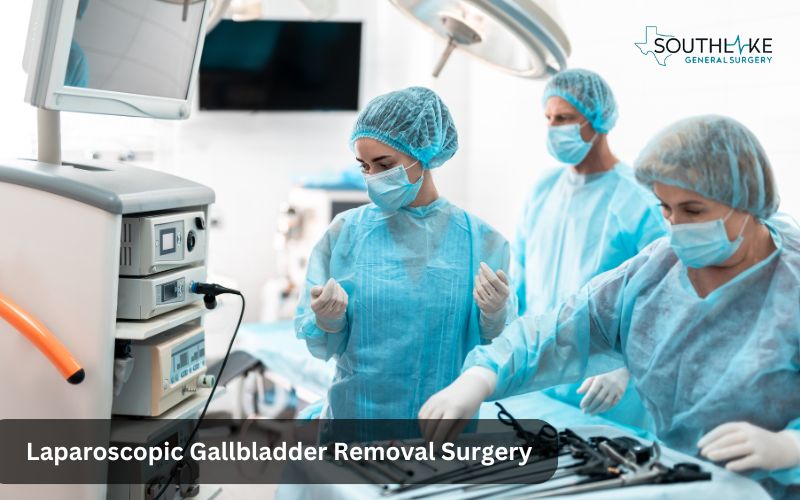
Surgical removal of the gallbladder, known as cholecystectomy, is a common and effective treatment for gallbladder stones. There are two main approaches to gallbladder removal: laparoscopic cholecystectomy and open cholecystectomy.
- Laparoscopic cholecystectomy: This minimally invasive procedure involves making several small incisions in the abdomen and using a laparoscope, a thin tube with a camera, and surgical tools, to remove the gallbladder. The advantages of laparoscopic surgery include smaller incisions, less scarring, and faster recovery time.
- Open cholecystectomy: In some cases, open surgery may be necessary, particularly if there are complications or if the gallbladder cannot be safely removed using laparoscopic techniques. Open cholecystectomy involves making a larger incision in the abdomen to remove the gallbladder.
The choice of surgical approach depends on various factors, including the individual’s overall health, the presence of complications, and the surgeon’s expertise. Recovery time can vary but is generally shorter with laparoscopic cholecystectomy.
Non-Surgical Treatments and Home Remedies
In addition to surgical removal, non-surgical treatments, and home remedies may be considered for managing gallbladder stones. These options are typically reserved for individuals who are not suitable candidates for surgery or prefer non-invasive approaches. Some non-surgical treatments and home remedies include:
- Medications: Ursodeoxycholic acid or chenodiol may be prescribed to help dissolve cholesterol gallstones over time.
- Shock wave lithotripsy: This non-invasive procedure uses sound waves to break up gallstones, making them easier to pass or dissolve.
- Dietary changes: Modifying your diet to reduce the intake of high-fat foods and incorporating more fiber-rich foods can help prevent further stone formation and promote gallstone dissolution.
It is important to consult with a healthcare provider to determine the most appropriate non-surgical treatment or home remedy based on individual circumstances and the characteristics of gallbladder stones.
Recovery and Management Post-Gallbladder Removal
After gallbladder removal surgery, it is important to make certain adjustments to your diet and lifestyle to ensure a smooth recovery and long-term management. Some key considerations include:
- Diet adjustment: Following gallbladder removal, you may need to modify your diet to accommodate changes in the digestion and absorption of fats. This may involve gradually reintroducing high-fat foods and incorporating digestive enzymes or bile salts to aid in the digestive process.
- Long-term management: It is important to maintain regular check-ups with your healthcare provider to monitor post-surgery recovery and manage any potential complications. Lifestyle modifications, such as maintaining a healthy weight and avoiding rapid weight loss, can help prevent the formation of new gallstones.
By following the recommended post-surgery care and making necessary lifestyle adjustments, individuals can effectively manage life without a gallbladder and maintain a healthy digestive process.
Adjusting Your Diet for a Healthy Gallbladder-free Life
After gallbladder removal, adjusting your diet is essential for a healthy gallbladder-free life. Here are a few things to think about when it comes to your diet:
- Fat intake: Limiting your intake of high-fat foods can help prevent digestive discomfort, as your body may have difficulty digesting and absorbing fats without the gallbladder. Gradually reintroduce healthy fats, such as those found in nuts, avocados, and olive oil, to ensure a balanced diet.
- Digestive enzymes: Some individuals may benefit from incorporating digestive enzyme supplements to aid in the digestion of fats. These enzymes can help break down fats and improve digestion.
- Whole grains: Including whole grains in your diet can provide essential fiber and nutrients while promoting regular bowel movements.
- Balanced diet: Focus on a balanced diet that includes a variety of fruits, vegetables, lean proteins, and whole grains to support overall health and digestion.
- Bile salts: In some cases, bile salt supplements may be recommended to aid in the digestion and absorption of fats.
By making these dietary adjustments, individuals can maintain a healthy digestive process and minimize digestive discomfort after gallbladder removal.
Long-term Management and Care Post-Surgery
Long-term management and care following gallbladder removal surgery are essential to maintain digestive health and overall well-being. Some important considerations include:
- Regular check-ups: It is important to schedule regular check-ups with your healthcare provider to monitor post-surgery recovery, manage any potential complications, and discuss any digestive concerns.
- Lifestyle modifications: Adopting a healthy lifestyle that includes regular exercise, maintaining a healthy weight, and avoiding rapid weight loss can help prevent the formation of new gallstones and support overall digestive health.
- Managing complications: If you experience any complications or digestive issues post-surgery, such as diarrhea or abdominal pain, it is important to discuss these with your healthcare provider to determine the appropriate management strategies.
By staying proactive and maintaining regular communication with your healthcare provider, you can effectively manage life without a gallbladder and ensure optimal digestive health.
Preventative Measures Against Gallbladder Stones
Prevention is key when it comes to gallbladder stones. By adopting certain dietary and lifestyle practices, individuals can reduce the risk of developing gallstones. Some preventative measures include:
- Dietary tips: Following a diet that is low in saturated fats, high in fiber, and rich in whole grains, fruits, and vegetables can help reduce the risk of gallstone formation.
- Lifestyle changes: Maintaining a healthy weight through regular exercise and adopting healthy lifestyle habits can help prevent the development of gallstones.
- Gallstone prevention: Avoiding crash diets and rapid weight loss and maintaining a stable weight can reduce the risk of gallstone formation.
- Regular health screenings: Periodic health screenings can help identify potential risk factors and allow for early detection and intervention.
By incorporating these preventative measures into daily life, individuals can take proactive steps to reduce the risk of gallbladder stones and maintain optimal digestive health.
Dietary Tips and Lifestyle Changes to Prevent Gallstones
Making certain dietary and lifestyle changes can help prevent the formation of gallstones. Here are some tips to consider:
- Healthy fats: Choose sources of healthy fats, such as avocados, nuts, seeds, and olive oil, over saturated and trans fats found in processed foods and fried foods.
- Fiber-rich foods: Incorporate a range of fruits, vegetables, whole grains, and legumes in your diet to increase your fiber intake. These foods are high in fiber and can help regulate cholesterol levels and promote regular bowel movements.
- Moderate alcohol consumption: Limit alcohol consumption to moderate levels, as excessive alcohol intake can increase the risk of gallstone formation.
- Physical activity: Engage in regular physical activity, such as walking, jogging, or cycling, to maintain a healthy weight and promote overall well-being.
- Obesity prevention: Maintain a healthy weight through a combination of a balanced diet and regular exercise, as obesity is a risk factor for gallstone formation.
By adopting these dietary tips and lifestyle changes, individuals can reduce the risk of developing gallstones and promote overall digestive health.
Importance of Regular Health Check-ups and Ultrasounds
Regular health check-ups and ultrasounds play a crucial role in the prevention and early detection of gallbladder stones. Here’s why they are important:
- Ultrasound screenings: Regular ultrasound screenings can help identify the presence of gallstones and assess the overall health of the gallbladder. These screenings can detect early signs of gallstone formation and enable timely intervention.
- Early detection: Detecting gallstones early can help prevent complications and allow for appropriate management strategies to be implemented.
- Risk factor assessment: Health check-ups provide an opportunity to assess individual risk factors for gallstone formation, such as obesity, family history, and dietary habits.
- Gallbladder health: Monitoring the health of the gallbladder through regular check-ups and ultrasounds allows for proactive management and prevention of gallstone-related issues.
- Follow-up appointments: Regular follow-up appointments with healthcare providers ensure ongoing monitoring of gallbladder health and allow for adjustments to treatment plans if necessary.
By prioritizing regular health check-ups and ultrasounds, individuals can stay proactive in managing their gallbladder health and reduce the risk of complications associated with gallbladder stones.
A Note From Southlake General Surgery
At Southlake General Surgery, we understand the importance of gallbladder health and offer expert care and treatment options for gallbladder stones. Our experienced surgeons are skilled in performing both laparoscopic and open cholecystectomies, ensuring the most appropriate surgical option for each patient.
We are committed to providing personalized care and patient education, ensuring that individuals have a thorough understanding of their condition and treatment options. With our team of professionals, patients can expect quality treatment and compassionate care throughout their gallstone journey.
Conclusion
In conclusion, understanding gallbladder stones is crucial for timely diagnosis and management. Recognizing the symptoms, causes, and risk factors can help in seeking appropriate medical attention. Whether opting for surgical or non-surgical solutions, it’s essential to focus on recovery and long-term care post-treatment.
Prevention through dietary modifications and regular health check-ups plays a vital role in gallbladder health. If you have concerns about gallbladder stones, don’t hesitate to consult a healthcare professional.
For personalized guidance and expert advice, get in touch with Southlake General Surgery. Prioritize your health and well-being by taking proactive steps towards gallbladder health today.
Make An Appointment
If you are experiencing symptoms or have concerns about gallbladder stones, you can book an appointment with our healthcare expert today at +1 (817) 748-0200.
They will be able to evaluate your symptoms, perform the necessary tests, and provide appropriate guidance and treatment options based on your circumstances. Don’t hesitate to reach out and make an appointment to ensure your gallbladder health and overall well-being.
Frequently Asked Questions
Can Gallbladder Stones Dissolve on Their Own?
Gallbladder stones typically don’t dissolve on their own. In some cases, certain medications might help break down smaller stones, but surgery is often needed for larger ones. It’s important to consult a healthcare provider for proper evaluation and treatment options.
What is the duration of the recovery period following gallbladder surgery?
Recovery after gallbladder surgery varies but typically takes 1-2 weeks for laparoscopic surgery and 4-6 weeks for open surgery. Patients can resume normal activities gradually. Adhere to the post-operative guidelines for a successful healing process.
Are There Any Long-term Dietary Restrictions Post-Gallstone Surgery?
Yes, post-gallbladder surgery, avoid high-fat foods. Gradually reintroduce fiber and minimize processed foods. Embrace a balanced diet with fruits, veggies, and lean proteins. Stay hydrated and limit caffeine/alcohol. Seek personalized advice for optimal dietary adjustments post-surgery.
Medically Reviewed By: Dr. Valeria Simone MD
Board-certified General Surgeon at Southlake General Surgery, Texas, USA.
Follow us on Facebook and YouTube.
References:
- Gulaya K, Desai SS, Sato K. Percutaneous Cholecystostomy: Evidence-Based Current Clinical Practice. Semin Intervent Radiol. 2016;33(4):291-296. https://doi:10.1055/s-0036-1592326
- Stinton LM, Shaffer EA. Epidemiology of gallbladder disease: cholelithiasis and cancer. Gut Liver. 2012;6(2):172-187. https://doi:10.5009/gnl.2012.6.2.172
- Jones, M. W., Weir, C. B., & Ghassemzadeh, S. (2023, April 24). Gallstones (Cholelithiasis). StatPearls – NCBI Bookshelf. https://www.ncbi.nlm.nih.gov/books/NBK459370/
- Website, N. (2024, January 29). Recovery. nhs.uk. https://www.nhs.uk/conditions/gallbladder-removal/recovery/
- Pak M, Lindseth G. Risk Factors for Cholelithiasis. Gastroenterol Nurs. 2016;39(4):297-309. https://doi:10.1097/SGA.0000000000000235
- Symptoms & Causes of Gallstones. (2022, August 30). National Institute of Diabetes and Digestive and Kidney Diseases. https://www.niddk.nih.gov/health-information/digestive-diseases/gallstones/symptoms-causes

